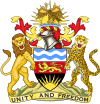The United Nations Educational, Scientific and Cultural Organization (UNESCO) World Heritage Sites are places of importance to cultural or natural heritage as described in the UNESCO World Heritage Convention, established in 1972.[1] Cultural heritage consists of monuments (such as architectural works, monumental sculptures, or inscriptions), groups of buildings, and sites (including archaeological sites). Natural features (consisting of physical and biological formations), geological and physiographical formations (including habitats of threatened species of animals and plants), and natural sites which are important from the point of view of science, conservation, or natural beauty, are defined as natural heritage.[2] Malawi accepted the convention, making its historical sites eligible for inclusion on the list. As of 2023, there are two World Heritage Sites in Malawi.[3]
World Heritage Sites
UNESCO lists sites under ten criteria; each entry must meet at least one of the criteria. Criteria i through vi are cultural, and vii through x are natural.[4]
| Site | Image | Location (region) | Year listed | UNESCO data | Description |
|---|---|---|---|---|---|
| Lake Malawi National Park | 
|
Central Region, Southern Region | Natural (vii) (ix) (x) | 1984 | Located at the southern end of the great expanse of Lake Malawi, with its deep, clear waters and mountain backdrop, the national park is home to many hundreds of fish species, nearly all endemic. Its importance for the study of evolution is comparable to that of the finches of the Galapagos Islands.[5] |
| Chongoni Rock-Art Area | 
|
Central Region | Cultural (iii) (vi) | 2006 | Situated within a cluster of forested granite hills and covering an area of 126.4 km2, high up the plateau of central Malawi, the 127 sites of this area feature the richest concentration of rock art in Central Africa. They reflect the comparatively scarce tradition of farmer rock art, as well as paintings by BaTwa hunter-gatherers who inhabited the area from the late Stone Age. The Chewa agriculturalists, whose ancestors lived there from the late Iron Age, practised rock painting until well into the 20th century. The symbols in the rock art, which are strongly associated with women, still have cultural relevance amongst the Chewa, and the sites are actively associated with ceremonies and rituals.[6] |
Tentative list
In addition to sites inscribed on the World Heritage List, member states can maintain a list of tentative sites that they may consider for nomination. Nominations for the World Heritage List are only accepted if the site was previously listed on the tentative list.[7] Malawi maintains six properties on its tentative list.[3]
| Site | Image | Location (region) | Year listed | UNESCO criteria | Description |
|---|---|---|---|---|---|
| Mulanje Mountain Biosphere Reserve | 
|
Southern Region | Natural (x) | 2000 | [8] |
| Nyika National Park | 
|
Northern Region | Mixed | 2000 | [9] |
| Khulubvi And Associated Mbona Sacred Rain Shrines | Southern Region | Cultural (iii) (v) | 2011 | [10] | |
| Malawi Slave Routes and Dr. David Livingstone Trail | 
|
Central Region | Cultural (iii) (iv) | 2011 | [11] |
| Lake Chilwa Wetland | 
|
Southern Region | Natural (ix) (x) | 2011 | [12] |
| Vwaza Marsh Wildlife Reserve | 
|
Northern Region | Mixed (iii) (v) (viii) (ix) (x) | 2011 | [13] |
References
- ^ "The World Heritage Convention". UNESCO World Heritage Centre. Archived from the original on 27 August 2016. Retrieved 7 July 2019.
- ^ "Convention Concerning the Protection of the World Cultural and Natural Heritage". UNESCO World Heritage Centre. Archived from the original on 1 February 2021. Retrieved 3 February 2021.
- ^ a b "Malawi". UNESCO World Heritage Centre. Retrieved November 20, 2023.
- ^ "UNESCO World Heritage Centre – The Criteria for Selection". UNESCO World Heritage Centre. Archived from the original on 12 June 2016. Retrieved 17 August 2018.
- ^ "Lake Malawi National Park". UNESCO World Heritage Centre. Retrieved 10 March 2024.
 Text was copied from this source, which is available under a Creative Commons Attribution 3.0 IGO (CC BY 3.0 IGO) license.
Text was copied from this source, which is available under a Creative Commons Attribution 3.0 IGO (CC BY 3.0 IGO) license.
- ^ "Chongoni Rock-Art Area". UNESCO World Heritage Centre. Retrieved 10 March 2024.
 Text was copied from this source, which is available under a Creative Commons Attribution 3.0 IGO (CC BY 3.0 IGO) license.
Text was copied from this source, which is available under a Creative Commons Attribution 3.0 IGO (CC BY 3.0 IGO) license.
- ^ "Tentative Lists". UNESCO World Heritage Centre. Archived from the original on 24 September 2005. Retrieved 7 October 2010.
- ^ "Mulanje Mountain Biosphere Reserve". UNESCO World Heritage Centre. Retrieved 10 March 2024.
- ^ "Nyika National Park". UNESCO World Heritage Centre. Retrieved 10 March 2024.
- ^ "Khulubvi And Associated Mbona Sacred Rain Shrines". UNESCO World Heritage Centre. Retrieved 10 March 2024.
- ^ "Malawi Slave Routes and Dr. David Livingstone Trail". UNESCO World Heritage Centre. Retrieved 10 March 2024.
- ^ "Lake Chilwa Wetland". UNESCO World Heritage Centre. Retrieved 10 March 2024.
- ^ "Vwaza Marsh Wildlife Reserve". UNESCO World Heritage Centre. Retrieved 10 March 2024.



